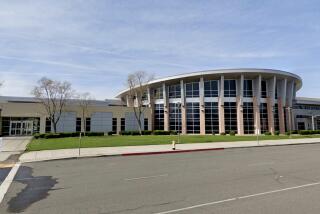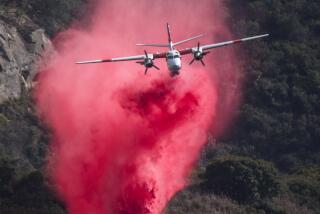4 Victims of Midair Collision Loved to Fly
Tom Quist was an adventure-seeking pilot who fished by seaplane in Alaska and swooped down on rural highways during visits to Iowa. The past 10 years of his life had been dedicated to reviving a Bakersfield aviation company with a cursed history.
Kevin Kaff was a 22-year-old aspiring commercial pilot who spent Friday nights working on his own kit plane and “loved being above,” his mother said.
Charles Oliver, a charter jet pilot, had just bought the performance aircraft of his dreams, a lipstick-red Questair Venture that cost him $130,000 and could buzz around at 300 mph.
Jean Bustos, an Air Force veteran, was the daughter of a pilot and the wife of an Air Force mechanic, and had logged hundreds of hours in the cockpit herself.
The four were killed in a midair plane collision over the heavily traveled Newhall Pass on Monday, Quist and Kaff in a Bellanca Citabria, Oliver and Bustos in Oliver’s experimental Questair Venture.
Investigators with the National Transportation Safety Board have moved the wreckage to a private hangar in Compton, where they will try to reconstruct the moments before the accident.
NTSB officials also will look at air traffic control data from the Federal Aviation Administration, information on the aircraft, and the pilots’ backgrounds and qualifications.
All four victims shared a love of flying, choosing a way of life that often put them in small, lightweight planes that fly at low altitudes. When their two planes crashed over Sylmar, the pilots were flying under “see and avoid” rules and not relying on radar or air traffic controllers.
Quist, 45, had logged thousands of hours flying and was meticulous about safety, said Roger Oxborrow, the manager of a small airfield in Paso Robles that Quist often used. A former pilot for American Eagle, Quist owned Patroline Inc., which surveyed pipelines for oil companies, including Shell and Mobil. He and Kaff were inspecting a pipeline at the time of the 9:48 a.m. crash.
Petroline has had a history of tragedy. The company was founded by Robert Smoot, a World War II pilot who died in a crash near Shandon, Calif., in 1954 when his plane clipped a power line, Quist’s associates said.
Smoot’s family sold the business to another pilot, Archie Dean, who also died on the job, suffering a brain aneurysm in 1982 while pushing a small plane out of a hangar in Colorado.
Smoot’s son then ran the business for several years before selling it in 1990 for $100,000 to Tom Quist, a tall, serious pilot with an athlete’s strut and a mind for numbers.
“Tom had the gift of the gab,” his brother David said. “He was confident. He was popular. He had the guts to do anything.”
Tom turned Patroline around, hiring more pilots, landing more contracts and moving the business from San Luis Obispo to Bakersfield, which is more central to major pipeline routes. After the 1998 fatal crash of one of his pilots surveying pipelines near Gorman, Quist flew the route himself.
Friends said recently that he had talked of selling the business, moving to a farm and spending more time fishing and skiing. Recently, he had inherited a 3,000-acre corn and soybean farm in western Iowa, where he had summered since he was a boy.
Kaff, an airplane junkie from Bakersfield, was to be in the next generation of Patroline pilots. Kaff, learning the pipeline route from Quist, had just received his commercial pilot’s license last month, his mother said.
“He loved flying, he loved being above, the freedom and the openness of the sky,” said Janice Kaff.
The same was true of Oliver and Bustos.
Oliver, 53, of Glendora, was a charter jet pilot for Petersen Aviation in Van Nuys. He had saved for a decade to buy the Questair Venture for $130,000 two months ago and had flown it every day since, said his wife Ann. If he wasn’t at the Brackett Field hangar in La Verne waxing or fixing his planes, she said, he was flying.
“He’d rather fly than breathe,” she said.
Oliver became an aviation aficionado during his service in Okinawa, Japan, with the Air Force when he went on a demonstration ride.
He had flown for 25 years, training other pilots and shuttling luminaries such as Elizabeth Taylor and Ronald Reagan.
Fellow pilots described Oliver as generous, routinely giving out the combination to the lock on his hangar so others could borrow tools.
“Charlie was always there for you,” said Don Brandt of San Dimas, who knew Oliver for 13 years.
Bustos, 65, was one of Oliver’s former students and often accompanied him during flights.
“Flying had been in her family almost all the way back to when flying began,” said Bustos’ nephew, Jerry Hill of Phoenix.
Bustos’ father, John C. Hamilton, was a fighter pilot in the Royal Canadian Air Force.
In the 1920s, Hamilton moved the family to Southern California. Born in Los Angeles, Bustos joined the U.S. Air Force in the 1950s. There she met her husband, Trinidad Bustos, an airplane mechanic.
After he was struck and killed by a propeller in 1957, she moved to the San Gabriel Valley and worked for the Charter Oak school district in Covina. About 10 years ago, she got her pilot’s license and bought an airplane. One of her favorite flying buddies was Charlie Oliver.
“They were great friends,” Hill said. “They would go flying at the drop of a hat.”
Bustos owned a plane for several years and had recently been trained to fly seaplanes. Like Quist, she wanted to take trips to Alaska and land on lakes.
“She wanted to fly all kinds of planes,” Hill said. “She was always renting airplanes that she thought she might like.”
“One thing that’s definite,” Hill said. “She loved what she was doing when she died.”
Times staff writers Joe Mozingo, Martha L. Willman, Andrew Blankstein, Johnathon E. Briggs and Karen Robinson-Jacobs and Times librarian Ron Weaver contributed to this story.
--- UNPUBLISHED NOTE ---
The Aircraft Owners and Pilots Association advises that the airplane patrolling the pipeline is more properly identified as a Bellanca Scout, omitting Citabria. The National Transportation Safety Board officially refers to the aircraft as a Bellanca, Model 8GCBC.
--- END NOTE ---
More to Read
Sign up for Essential California
The most important California stories and recommendations in your inbox every morning.
You may occasionally receive promotional content from the Los Angeles Times.











